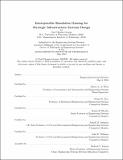| dc.contributor.advisor | Olivier L. de Week | en_US |
| dc.contributor.author | Grogan, Paul Thomas, 1985- | en_US |
| dc.contributor.other | Massachusetts Institute of Technology. Engineering Systems Division. | en_US |
| dc.date.accessioned | 2014-09-19T21:43:51Z | |
| dc.date.available | 2014-09-19T21:43:51Z | |
| dc.date.copyright | 2014 | en_US |
| dc.date.issued | 2014 | en_US |
| dc.identifier.uri | http://hdl.handle.net/1721.1/90169 | |
| dc.description | Thesis: Ph. D., Massachusetts Institute of Technology, Engineering Systems Division, 2014. | en_US |
| dc.description | Cataloged from PDF version of thesis. | en_US |
| dc.description | Includes bibliographical references. | en_US |
| dc.description.abstract | Infrastructure systems are large physical networks of interrelated components which produce and distribute resources to meet societal needs. Meeting future sustainability objectives may require more complex systems with stronger integration across sectors and improved collaboration among constituent organizations. This dissertation introduces and demonstrates a method of interoperable simulation gaining to combine elements from concurrent engineering, wargaming, and serious gaming to support strategic design activities. First, a controlled human subjects experiment quantifies the relative impacts of technical and social sources of complexity using a simple surrogate design task, finding collaboration with communication barriers greatly increases the time and cost of design. Next, a modeling framework identifies common graph-theoretic structures and formal behavior definitions believed to be generalizable to all infrastructure systems. An interoperability interface defines interactions between system models to eiable resource exchanges. Next, the High Level Architecture (HLA) standard is applied to the modeling framework to enable distributed, time-synchronized simulation with deceitralized authority over constituent system models. A federation object model and agreement define data structures and processes to participate in a federated simulation execution. A prototype application case implements the modeling framework and simulation architecture using the context of Saudi Arabia. Infrastructure system models are developed for agriculture, water, petroleum, and electricity sectors. A baseline scenario develops system and element instantiations using historical estimates of resource flows and fictional costs. A software implementation provides a graphical user interface to modify design scenarios and visualize outcomes. Finally, a game formulation uses the prototype model as the basis of a simulation game with individual and collective objectives among water, energy, and agriculture ministry roles. Players collaboratively propose new infrastructure projects over a planning horizon to maximize objectives within time and budgetary constraints. A second controlled human subjects experiment studies the effect of three tool variants of outcome design quality, finding the number of data exchanges is positively correlated with outcome quality and am integrated simulation variant using the HLA results in more data exchanges compared to am asynchronous file-based variant. | en_US |
| dc.description.statementofresponsibility | by Paul Thomas Grogan. | en_US |
| dc.format.extent | 293 pages | en_US |
| dc.language.iso | eng | en_US |
| dc.publisher | Massachusetts Institute of Technology | en_US |
| dc.rights | M.I.T. theses are protected by copyright. They may be viewed from this source for any purpose, but reproduction or distribution in any format is prohibited without written permission. See provided URL for inquiries about permission. | en_US |
| dc.rights.uri | http://dspace.mit.edu/handle/1721.1/7582 | en_US |
| dc.subject | Engineering Systems Division. | en_US |
| dc.title | Interoperable simulation gaming for strategic infrastructure systems design | en_US |
| dc.type | Thesis | en_US |
| dc.description.degree | Ph. D. | en_US |
| dc.contributor.department | Massachusetts Institute of Technology. Engineering Systems Division | |
| dc.identifier.oclc | 890206049 | en_US |
